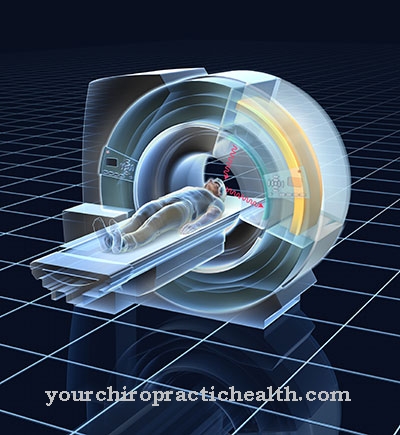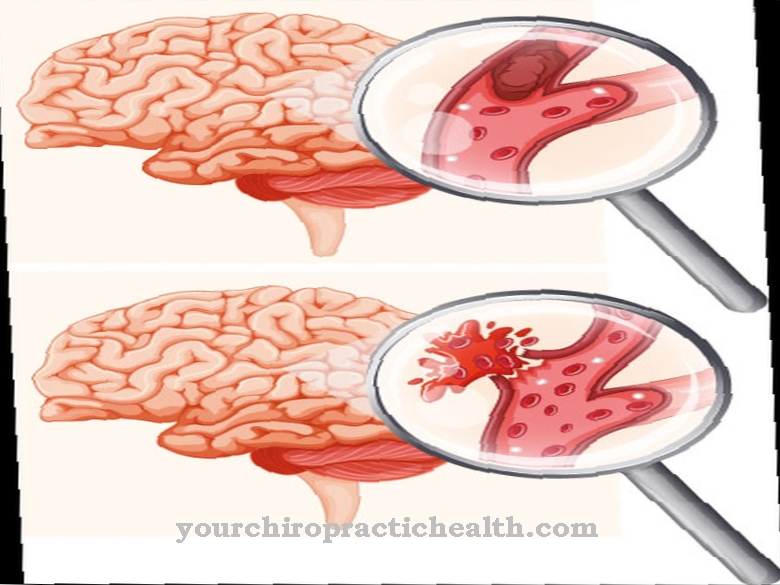Long periods of sitting at the computer, a strenuous drive, an uncomfortable bed: Neck tension have many causes, usually occur unexpectedly and can be very annoying. The pain in the neck can radiate into the shoulders and back of the head. Sometimes neck tension disappears quickly on its own, but sometimes the pain is more persistent and a visit to the doctor is necessary.
What is neck tension?

Impaired mobility and sore muscles are the basic symptoms of neck tension. The free movement of the head in all directions is no longer possible, and sometimes the mobility of the chest and shoulder area is impaired. Rotational movements of the upper body are not possible or only possible to a limited extent and are associated with neck pain.
The doctor calls the pain in the neck cervical syndrome or cervical spine syndrome (cervical spine syndrome). All forms of neck pain are summarized under this term. Depending on the duration, a distinction is made between an acute (up to three weeks), a subacute (up to twelve weeks) and a chronic (longer than twelve weeks) course.
The longer the pain persists, the more likely it is that the affected structures will be damaged, that the existing symptoms will become chronic or that there will be consequential damage.
causes
In most cases, the tension has built up over a longer period of time and announced by signs such as headache, burning eyes or tiredness. The earlier the treatment of neck tension begins, the faster the symptoms will disappear. There may also be an uncomfortable tingling sensation in the neck, a dull, dragging pain, migraine-like headache or a feeling of numbness in the fingers.
The forms of neck tension are as diverse as their causes. Cramping of the neck muscles and associated nerve irritation can occur without a clear cause or in connection with another illness, often with a cold. One-sided stress in combination with a lack of exercise, uncomfortable sleeping or sitting positions as well as stress and drafts are also seen as causes. Overloading, heavy carrying or lifting, jerky movements or drafts can also be the cause.
Sometimes the reason is deeper: Experts cite signs of wear and tear on the extremely flexible and very susceptible cervical vertebrae and their intervertebral discs as a rare cause of neck tension. Previous illnesses, whether known or not, are also the cause of cramped neck and neck muscles. In connection with meningitis, rheumatic or neurological diseases, inflammation of the vertebral bodies, malpositions of the spine or vascular diseases, the neck can also stiffen.
Other triggers can be osteoporosis, infectious diseases such as listeriosis or salmonella infection, but also bone tumors and lymphomas. If neck tension occurs after an accident, it is often a whiplash injury. Caution is advised here: It could also be a broken vertebra that needs immediate medical attention. A congenital bad posture like the torticollis is rarely the cause of the pain.
You can find your medication here
➔ Medicines for back painSymptoms, ailments & signs
In addition to the tension in the muscles in the neck, back of the head and shoulders, other symptoms can occur. The mobility of the head and cervical spine can be restricted, and pain in the shoulders and shoulder joints is often mentioned.
Nausea and vomiting, headaches and even migraines and the associated visual disturbances often occur in connection with neck problems. But also noises in the ears, shortness of breath, dizziness and fatigue are symptoms that are associated with cramped neck and neck muscles. Weakness in the legs is only occasional. Many of the complaints are attributed to the increased pressure of the muscles on the nerve tracts. Excessive muscle tone is felt to be more uncomfortable the longer it lasts.
If an accident or a sudden event is the cause of the muscle hardening, if the pain occurs in a flash or if it is accompanied by brief loss of consciousness, it is advisable to consult a doctor immediately. In all cases, the following applies: The restriction of mobility carries an increased risk of accidents. Doctors advise against activities that require a high degree of mobility in the cervical spine. Driving should be avoided. Carrying and lifting heavy objects or unilateral strain on the neck and neck muscles can increase the symptoms and damage the cervical spine.
Complications
If the tension persists for a long time and it does not go away on its own, further complaints often arise. The impairment of the nerves can lead to numbness in the neck and shoulders, but also in the fingers and hands. Even a feeling of weakness in the legs can be caused by neck tension.
When should you go to the doctor?
If there are symptoms that cannot be immediately assigned to tension, caution is called for. For example, significant weight loss may indicate a more serious cause. An immediate doctor's visit is indicated even in the event of a radical deterioration in mental health.
If the coronary arteries have a disease such as myocardial infarction (heart attack) or angina pectoris, neck tension can also occur. Severe psychological stress and prolonged stress can lead to a stiff neck even without an orthopedic diagnosis. If symptoms of paralysis occur in the arms or hands, a doctor should be consulted.
diagnosis
The physical examination by the doctor clarifies whether there are malfunctions in the musculoskeletal system, joints, tendons or ligaments. An overload of the musculature is checked as well as a strain or a possible herniated disc. It is determined how flexible the cervical spine is or whether nerves are pinched. The extent of bad posture, the quality of the muscles and possible external causes such as accidents or jerky movements are included in the diagnosis.
Other diagnostic options can also be used to clarify the cause of the disease. A blood count excludes infectious diseases and Lyme disease, while imaging procedures such as an X-ray, computed tomography (CT) or magnetic resonance tomography (MRT) provide reliable information about orthopedic causes.
A herniated disc would show up here as well as a pathological change in bones or intervertebral discs. Once the reasons for the disease have been clarified, treatment of the symptoms can begin.In consultation with the patient, the doctor will show the appropriate methods to alleviate symptoms and permanently eradicate the cause of the impairment.
Treatment & Therapy
Warmth usually relieves the symptoms of tense neck and neck muscles. Blood circulation-promoting ointments with camphor or peppermint oil are also tried and tested first aid measures. If the disease persists, self-treatment is not advisable. A doctor should be consulted at the latest after a few days with the pain in the neck or if the symptoms worsen.
If the disease is very severe, for example paralysis of the arms, or if you have a known pre-existing condition (e.g. osteoporosis or rheumatism), you should consult a doctor. This will define the scope of the examination through a specific anamnesis and initiate treatment. The question of the duration of the existing pain is also part of the initial anamnesis as is the reconstruction of the course of the disease, the determination of the severity of the pain and the question of other existing diseases.
Which measures the doctor suggests depends on the severity of the impairment and the pain felt by the patient. In the case of severe complaints, we recommend relieving the cervical spine with the help of a special foam collar or an ergonomically shaped neck pillow. Complementary measures such as acupuncture or naturopathic procedures must be weighed up on a case-by-case basis. Surgery may only be necessary in rare cases and after all other measures have been exhausted.
First, the acute symptoms are treated. Tensions usually respond well to therapeutic measures: massages, heat applications such as fango packs or red light are often used. The attending physician usually combines manual treatment with physiotherapy units. The aim is to loosen up the muscles, loosen sticky fasciae and reduce stress.
The tape technique with special kinesiological adhesive tapes that are applied to the skin can also provide relief. The bands act like a permanent massage and stretch gently. Depending on how the patient feels, the doctor will prescribe pain relievers (e.g. paracetamol) and non-steroidal rheumatics (e.g. ibuprofen, diclofenac) to quickly relieve the pain.
Targeted injections of narcotic drugs such as lidocaine into the myofascial trigger points, where the tense muscle bundles converge, may be used. The syringes have proven to be very effective, especially in combination with stretching exercises. Light movement such as walks, gentle gymnastics, targeted stretching exercises or relaxed swimming support relaxation and, if used correctly, provide relief even for acute complaints.
The doctor often recommends the additional use of heat pillows, saunas and hot baths. Manipulation of the cervical spine with chiropractic handles should be viewed with caution: This type of treatment should always be very gentle and rough jerking or tearing should be avoided at all costs. This type of treatment may only be performed by certified doctors.
You can find your medication here
➔ Medicines for back painOutlook & forecast
The prognosis of neck tension is favorable. Most of the people affected are disorders of everyday movement. The load on the organism is not optimal and therefore triggers tension in the neck area. If the muscular system is supported by compensatory or therapeutic movements, in most cases the symptoms will be relieved within a short period of time. In addition, the person concerned can independently contribute to improving his or her health through regular sporting activities.
If one-sided physical stress or bad posture is avoided, the symptoms can also be alleviated. Heat baths or massages also help with long-lasting or deep-seated tension. These lead to a loosening of the muscle fibers and relieve the existing tension accordingly. In order to be permanently free of symptoms, it is essential to change the sequence of movements. Otherwise, the relapse rate for neck tension is very high.
If the tension is triggered by disorders of the skeletal system, physiotherapy exercises are necessary for long-term improvement in general health. These should also be used independently by the patient outside of the therapy hours in order to take preventive measures. If the person concerned is unable to carry out compensatory movement exercises due to a severe underlying disease, the symptoms will only be alleviated as soon as the underlying disease has subsided or has been cured.
prevention
For a permanent improvement of the condition, the doctor will emphasize the relaxation of the muscle tissue and the loosening of stuck muscle fascia in order to lower the basic tone of the muscles. Regular exercise and a good mental condition are just as important in order not to cause new complaints. One-sided stress and monotonous movements should be avoided.
Stress hormones such as cortisol, adrenaline and noradrenaline favor the symptoms: stress reduction, mobility and suppleness are therefore preventive in the foreground. Loose running, swimming or other endurance sports improve blood circulation and supply the muscles with blood and oxygen. This strengthens the immune system and prevents infectious diseases that can also trigger neck tension. Physiotherapy is recommended for very pronounced symptoms and is often prescribed by the doctor in conjunction with passive heat applications.
Aftercare
Follow-up care after neck tension is very important. It is the same as prevention, since the aim is to prevent the unpleasant symptoms from flaring up again. It is ideal for this if the person concerned is aware of how the neck tension came about.
If the cause is an unhealthy posture, for example in the workplace, ergonomic design is an important part of aftercare. Breaks during work are also important in order to be able to relax the neck again. This is especially true for everyone who sits bent over at their desk or PC. Anyone who uses the phone a lot and has the habit of holding the phone between head and shoulder would do well to configure a suitable headset for aftercare.
If the neck tension is the cause of an unfavorable position of the cervical spine in bed, the mattress and pillow should be reconsidered. Orthopedists, physiotherapists and often the appropriately qualified specialist staff in the specialist bed shop can help here.
If the neck tension has been treated with physiotherapy, the patient has usually also learned exercises that should be continued at home. This is also an integral part of the follow-up care for this disease. If drafts were the cause of the neck tension, this should be avoided consistently. This is especially true for wet hair after a shower.
You can do that yourself
With the help of back exercises, not only the neck, but the entire systemically connected muscles on the back, neck and front of the body as well as on the shoulders and arms are worked: Strengthening, mobility, mobilization and stretching are the top priorities.
Gentle yoga pulls the tense muscles back into shape, but also uses meditative elements to reduce stress and promotes the oxygen supply with breathing techniques. Relaxation techniques such as progressive muscle relaxation ensure an improved awareness of the body and your own stress level. Many of these courses are subsidized by health insurance companies.



.jpg)


.jpg)




















